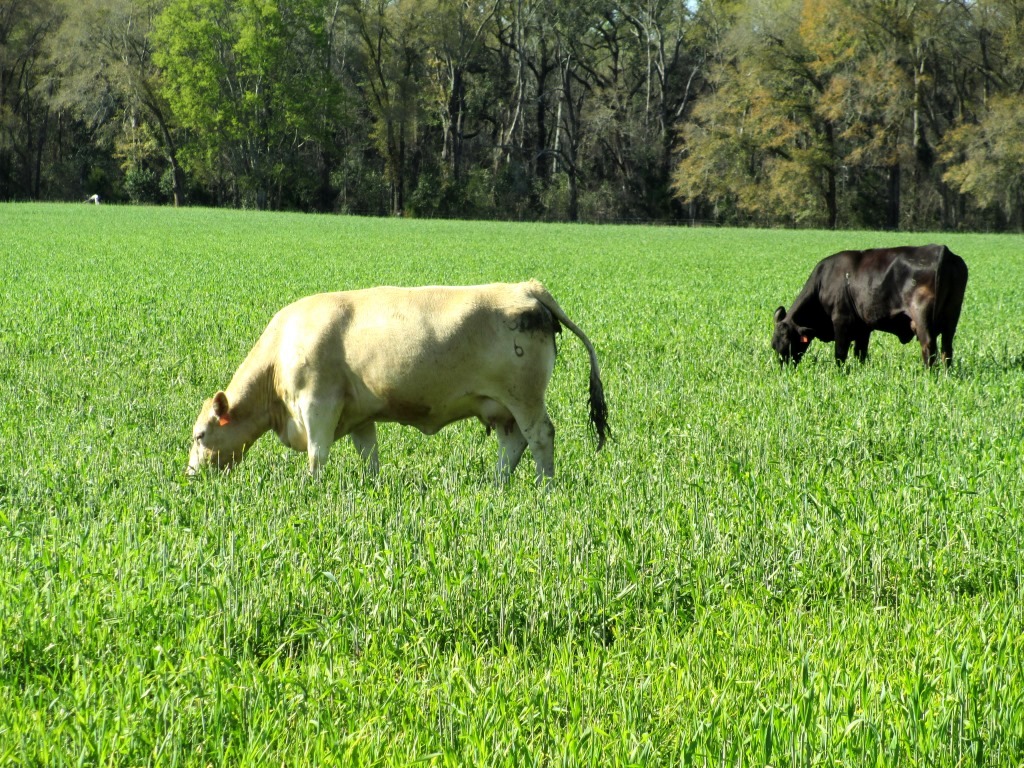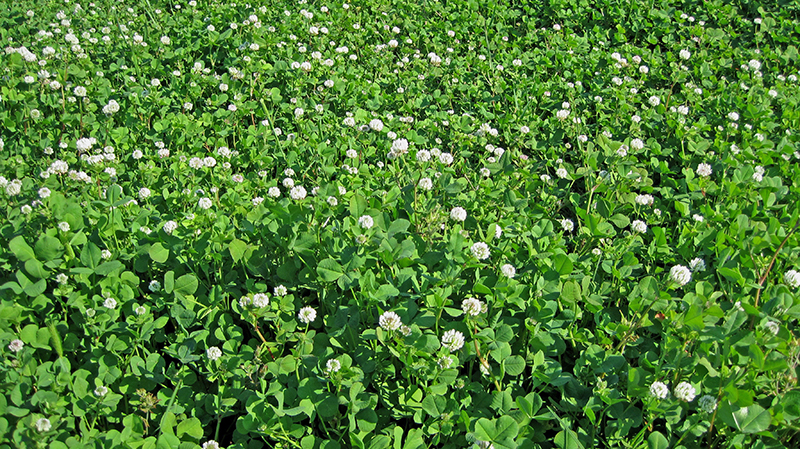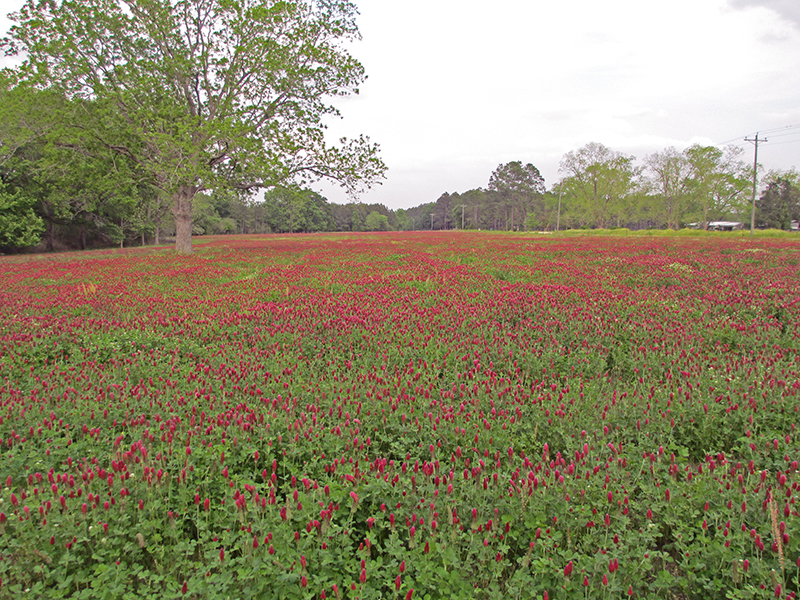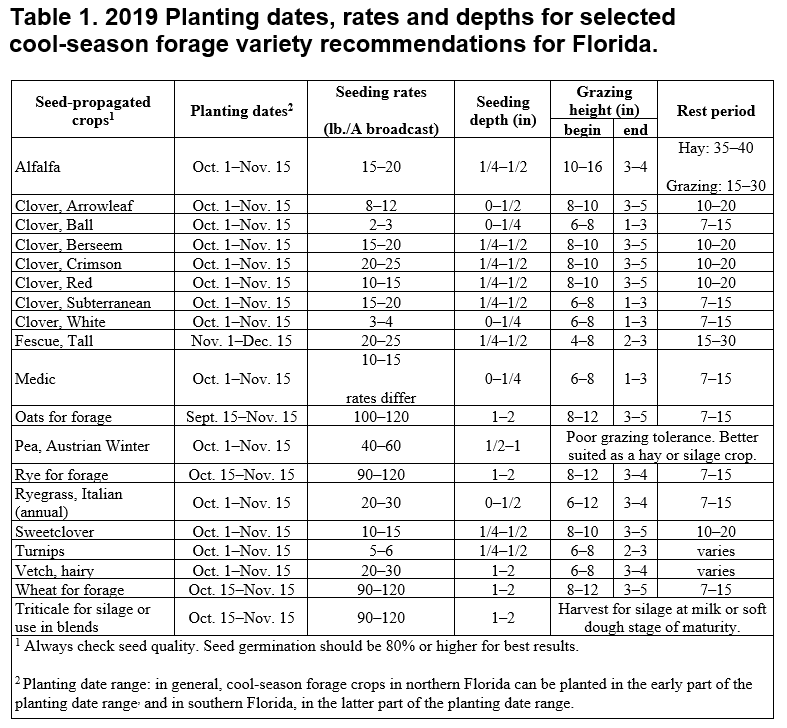
Cows grazing rye/ryegrass blend plantred with a no-till drill on a Bermudagrass hay field at the NFREC Beef Unit, Marianna, FL. Credi: Doug Mayo, UF/IFAS
A. Blount, M. Wallau, E. Rios, J. M. B. Vendramini, J. C. B. Dubeux, Md. A. Babar, K. E. Kenworthy, and K. H. Quesenberry, UF/IFAS Agronomy Department
Perennial warm-season pasture grasses used in Florida become dormant in late fall and winter because of short days, cooler temperatures, and frosts. Many livestock producers may choose to establish cool-season annual pasture species to supplement their forage production. These plants are usually higher in total digestible nutrients (TDN) and crude protein (CP) than summer perennial grasses. Planting and growing these forage crops can involve considerable expense, and is somewhat risky because rainfall is often unpredictable during the fall establishment period. The species and varieties for potential use vary in the distribution of production during the cooler months and in the type of soils where they are best adapted.
Many cool-season forages are also grown as silage crops or as cover crops, in addition to their use for grazing. If grown for silage or cover cropping, delaying planting by 1 month, or similar planting dates to those of varieties grown for grain, is recommended. If multiple silage cuttings are desired, planting may occur at the same time as normally recommended planting dates for grazing, however harvesting must occur when plants are still in the vegetative stage to avoid potential freeze damage or winter kill of the stand. Early planting for silage or for cover cropping has, in some years, made stands susceptible to diseases, insect pests, and lodging.
This publication provides the most up-to-date information on current adapted cool-season forage varieties. The recommendation of varieties is based on multi-location, multi-year cultivar evaluation experiments that may include trials in Georgia and other states. Table 1 includes information about the planting dates, seeding rates, and other considerations. If you have questions about a particular variety, contact your local county UF/IFAS extension agent for additional information.
Recommended Cultivars (Varieties)
–
Alfalfa
Alfalfa is usually grown as a winter short-term perennial in Florida, typically used for haylage, green chopping, or hay. Alfalfa requires good management practices for establishment and maintenance. It is not tolerant to flooding or soils with high water tables and requires a soil pH of 6.5 or greater. This species is not widely cultivated in Florida because it is difficult to produce timely hay cuttings with Florida’s humid conditions. However, the cost of producing alfalfa haylage and silage has decreased in recent years, and this has made it a viable and cost-effective option as a high quality, conserved legume forage. Some new cultivars have been developed for tolerating a certain amount of grazing but are not as grazing-tolerant as other legume species, such as most of the clovers.
Recommended Varieties: Alfagraze 600RR (Roundup Ready) and Bulldog 805

Commercial alfalfa field in Jackson County. Photo credit: Doug Mayo, UF/IFAS
Arrowleaf Clover
Arrowleaf clover is an annual species, similar to crimson clover in soil adaptation, management, and fertility requirements. It is mainly grown on heavier soils in northwestern Florida. Arrowleaf clover makes more growth in late spring than crimson clover.
Recommended Varieties: Blackhawk and Apache (for North and Central Florida). Yuchi is not recommended because it is an older variety and is more susceptible to disease. Blackhawk and Apache have improved virus resistance compared to Yuchi.
–
Ball Clover
Ball clover grows on a wide range of soil types, including poorly drained soils. Although it is well adapted, it is not considered to be a highly productive forage in Florida.
Recommended Varieties: Don, Grazer’s Select, and Segrest. Pre-inoculated seed is recommended.

Ball Clover overseeded in Tifton 85 Bermudagrass in Jackson County. Credit: Doug Mayo, UF/IFAS
Berseem Clover
Berseem clover has low bloat potential and is well adapted to many soil types in Florida, including more alkaline and wet soils. Care should be given to the management of berseem clover when grazed. It is advisable to graze at about 10 inches and leave a 3–4 inch stubble height.
Recommended Varieties: Bigbee and Frosty
–
Crimson Clover
This clover is a reseeding annual adapted to fertile, well-drained soils. It has a relatively short grazing season. Crimson clover may be grown in combination with ryegrass or a small grain crop.
Recommended Varieties: Dixie, AU-Sunrise and AU-Robin.

Crimson clover overseeded in Argentine bahiagrass in Jackson County. Credit: Doug Mayo, UF/IFAS
Red Clover
Red clover behaves as a winter annual under Florida conditions and usually does not reseed itself. It does not tolerate poorly drained soils. Red clover provides long-season forage production in North Florida.
Recommended Varieties: Barduro (mid-dormant, released by UF/IFAS), Red Ace, Southern Belle (non-dormant, released by UF/IFAS), and FL2,4D (resistant to 2,4-D herbicide, released by UF/IFAS). Southern Belle is a non-dormant red clover. It offers earlier forage production and greater total-season forage yields than more dormant varieties. Barduro is a UF red clover cultivar that is a mid-dormant type. Bulldog Red is also marketed in the southeastern United States but data is limited on its performance in Florida. FL2,4D was released by UF/IFAS in 2016 and licensed to Grassland Oregon. Seed of the 2,4-D red clover is not expected to be available commercially until at least fall of 2020.
–
White Clover
White clover is usually a winter perennial, but may act as an annual depending on moisture conditions. It is adapted to moist soils throughout Florida and is moderately tolerant to acidity. Production and persistence of white clover can be limited by nematodes and other pests.
Recommended Varieties: Louisiana S-1, Ocoee (released by UF/IFAS and nematode tolerant), Osceola (released by UF/IFAS), Regal Ladino, and Regalgraze. Durana is also well adapted, has a prostrate growth habit, and persists well under grazing, but it has lower initial forage yields.
–
Tall Fescue
In general, fescue should not be planted in Florida. It does not persist as a perennial, and small grains and ryegrass are more productive as a cool-season annual. A few producers have had limited success with Ga-5, a novel endophyte- infected fescue, when planted on low, wet clay soils in northwestern Florida.
Recommended Varieties: Max Q II and Texoma endophyte-friendly fescue where adapted.
–
Lupine
Lupine is an annual plant adapted to well-drained soils in northern and western Florida. It is an excellent cover crop. Seed supply has been low in recent years, and forage production has been limited by diseases and insects. Only sweet lupine varieties are suitable for forage.
Recommended Varieties: Tifblue. Frost and Tifwhite are also recommended; however, commercial seed production of these lupine varieties has been limited and seed is currently unavailable.
–
Medic
Medics are small seeded legumes that grow on a wide range of soil types. Although they are well adapted, they are not considered to be highly productive forages in Florida.
Recommended Varieties: Armadillo burr and Devine little burr medics. Pre-inoculated seed is recommended.
–
Oat
Oat is very palatable but is susceptible to freeze injury. Oat may be planted and grazed earlier than rye. Legend 567 and Horizon 720 are new crown rust resistant varieties. In 2013, a new strain of crown rust was identified on all commercially available eastern oat varieties and symptoms ranged from mild infection to early plant senescence. We recommend planting disease-resistant varieties when available; however, in grazing systems, crown rust resistance is less critical since rust inoculum is reduced by the grazing animal. Other commercially available varieties of oat are often are very productive, although susceptible to crown rust. Early planting of susceptible varieties is not recommended. Due to label restrictions, very few fungicides are available for use in forage oats. Horizon 306 and RAM LA 99016 are excellent forage types that have winter hardiness and good grain production, however are susceptible to the new strain of crown rust that is prevalent state-wide. Susceptible oat plantings may need to be scouted for rust and treated with legal fungicides, particularly if grown for silage or grain. In some years, some varieties, such as NK-Coker 227, may be injured by Barley Yellow Dwarf Virus (BYDV), an aphid transmitted virus. Typically, oat varieties grown for grazing, which are early planted, are not sprayed with insecticides for aphid control. Grazing reduces populations of aphids but may not prevent early infection of BYVD in early planted situations where warm fall weather prevails.
Recommended Varieties: Legend 567 (crown rust resistant), Horizon 720 (moderately resistant to crown rust), Horizon 306, Horizon 270 (crown rust susceptible), and RAM LA 99016 (moderately crown rust susceptible).
–
Austrian Winter Pea
This annual legume is best suited to well-drained soils with high clay content.
Recommended Varieties: Common, Maple, and Whistler.
–
Rye
Rye is the small grain most widely used for winter grazing. Rye is more cold tolerant than oats and generally produces more forage than either oat or wheat. If rye is planted very early in the season, there may be a decreased stand caused by various seedling diseases. Normally, rye developed for northern states produces little forage in late fall or early winter and is usually severely damaged by leaf rust. For these reasons, only plant varieties recommended for the southeastern United States.
Recommended Varieties: FL 401 (for early grazing or use in blends), Kelly Grazer III (PVP FL 104, full-season grazing), Wrens Abruzzi and late-forage season producers, Elbon and Bates RS4 (developed in Oklahoma).
–
Ryegrass
Ryegrass is a valuable winter and spring grazing crop for use on flatwoods soils or the heavier sandy loam soils in northwest Florida. Ryegrass may be seeded alone or with a small grain on a prepared seedbed or overseeded onto permanent grass pastures. Seeding ryegrass with a small grain crop lengthens the grazing season. (NOTE: Few differences were found between early and late variety performance in the 2016-17 season of production.)
Early Recommended Varieties: Andes, Attain, Big Boss, Credence, Diamond T, Earlyploid, Flying A, Fria, Lonestar, Marshall (susceptible to rust and gray leaf spot), Nelson, Prine, TAMTBO, and Tetrastar.
Late Recommended Varieties: Andes, Attain, Big Boss, Credence, Marshall (susceptible to rust and gray leaf spot), Nelson, Prine, TAMTBO, and Tetrastar.
Season-Long Recommended Varieties: Andes, Attain, Big Boss, Credence, Diamond T, Earlyploid, Flying A, Fria, Lonestar, Marshall (susceptible to rust and gray leaf spot), Nelson, Prine, TAMTBO, and Tetrastar.
These varieties were selected based on their recent three- year, multi-location performance. Other ryegrass varieties, such as Beefbuilder III, Big Daddy, Brigadier, Ed, Fantastic, Florlina, Fria, Graze-N-Gro, Jumbo, King, Maximus, Ocala, Passerel Plus, Rio, Surrey II, Verdure, and Winterhawk have also performed well in older regional trials. Other new varieties, like Frostproof (recently released by UF/IFAS), may be suitable but have not been adequately evaluated in Florida.
–
Sweetclover
Sweetclover grows on slightly drier soils than white clover. It will not tolerate flooding. Sweetclover has an earlier but shorter grazing season than white clover. Sweetclover should be reseeded each year.
Recommended Varieties: None at present. New varieties should be commercially available shortly.
–

Triticale and an early season ryegrass make a great combination for extending the grazing season and for silage harvest. Photo credit: Doug Mayo, UF/IFAS
Triticale
Triticale is a cross between wheat and rye. It is well adapted to the southern United States and peninsular Florida. Triticale has the forage quality of wheat and the excellent disease resistance of rye. Triticale does not respond well to close grazing and therefore is recommended for haylage or silage if grown alone. If used for grazing, consider blending with ryegrass to promote a longer growing season. It is advisable to use recommended varieties as there are triticale varieties sold in the state that are not adapted to Florida growing conditions and will not perform well.
Recommended Varieties: TriCal 342, TriCal 1143, TriCal Merlin Max, TriCal Surge and NF 201.
–
Vetch
Vetch grows best on well-drained, fertile, loamy soils. Although it is well adapted, it is not considered to be a highly productive forage in Florida.
Recommended Varieties: AU-Early Cover, Cahaba White, Hairy, Merit, and Nova II. Commercial seed production of most vetch varieties is limited and it may be necessary to special order seed.
–
Wheat
Wheat is similar to oat in forage yield and palatability. Wheat is less susceptible to freeze injury than oat. Wheat should not be planted for grazing before October 15 and take caution to plant only Hessian-fly-resistant varieties for grazing.
Recommended Varieties: AGS 2024, GrazeAll (AGS 2027), Pioneer 26R10, and Pioneer 26R41.
–

–
Remember the Following
- Planting cool-season forages on a clean-tilled seedbed results in earlier and more total forage production compared to overseeding on grass sod. If overseeding on bahiagrass, the sod should be disked to 30% disturbance. For overseeding on bermudagrass, a pasture drill or no-till drill can be used alone. Excess warm-season forage should always be removed as hay or by grazing before planting the cool-season forage.
- Success of winter pastures depends on adequate rainfall. This is especially true when overseeding.
- In central and south peninsular Florida, sod seeding (overseeding) of cool-season annuals into an established grass sod often fails because of insufficient soil moisture and warm-season grass competition. Sod seeding is generally not recommended unless irrigation is available, or rainfall is adequate.
- Look for opportunities to plant on a clean-till seedbed, such as following vegetables or a row crop, after lifting sod, or in a pasture renovation program where the sod is plowed or turned under.
- In south central Florida, small grains and ryegrass have been successfully grown on flatwoods in a pasture renovation program. If the sod is turned with a moldboard plow (late October-early November), the soil harrowed, planted, and packed the same day, there will usually be enough moisture conserved to establish the new planting. If equipment and labor does not allow for such a rapid progression of work, then it may be best to turn the sod and then disk in early to mid-October and wait for adequate rainfall before planting.
- Winter legumes are more dependable on the heavier clay soils of northwestern Florida or on sandy soils underlain by a clay layer compared to deep upland sands or sandy flatwoods. However, white clover and ryegrass overseeded can also be grown successfully on flatwoods soils in northeast Florida and south central Florida where the soil remains moist throughout the growing season.
- Remember to add the correct inoculant (nitrogen-fixing bacteria) to the legume seed before planting. Coated (pre-inoculated) seed is sometimes available, but seed coatings with bacteria have a limited shelf life and may be costly when compared to purchasing raw seed and inoculant separately and mixing just prior to planting. Be aware of proper storing for pre-inoculated seeds or inoculants; excess heat can kill bacteria.
- Cool-Season Forages – A Pasture Perspective for 2022 - September 16, 2022
- Ornamental Rhizoma Perennial Peanut for Groundcover or Alternative Turf - March 18, 2022
- 2021 Cool-Season Forage Recommendations for Livestock and Wildlife - September 24, 2021
